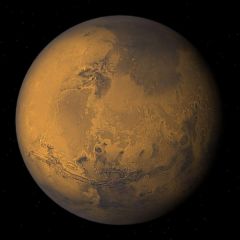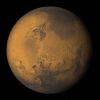 | This article, about a planet, is a stub. You can help Orbiterwiki by expanding it.
| Mars
|

|
| Mars in Orbiter 2016 with D3D9
|
| Designation
|
| Name |
Mars
|
| Reference body |
Sun
|
| Number of satellites |
|
| Planetary mean orbits
|
| Epoch |
J2000 (1 January 2000)
|
| Semimajor axis (a) |
1.52366231 AU
(2.279366372×1011 km)
|
| Eccentricity (e) |
0.09341233
|
| Inclination (i) |
1.85061°
(0.0322992 radian)
|
| Longitude of the ascending node (LAN, ☊) |
49.57854°
(0.8653088 radian)
|
| Longitude of periapsis (ϖ) |
336.04084°
(5.865019 radian)
|
| Mean longitude (L) |
355.45332°
(6.203831 radian)
|
| Planetary orbital element centennial rates
|
| Semimajor axis (a) |
-0.00007221 AU/Century
|
| Eccentricity (e) |
-0.00011902 Century-1
|
| Inclination (i) |
-46.94 seconds/Century
|
| Longitude of the ascending node (LAN, ☊) |
-1020.19 seconds/Century
|
| Longitude of periapsis (ϖ) |
1560.78 seconds/Century
|
| Mean longitude (L) |
68905103.78 seconds/Century
|
| Selected physical parameters
|
| Mean radius |
3389.92±0.04 km
|
| Mass |
6.418542×1023 kg
|
| Density |
3.9335±0.0004 g/cm3
|
| Sidereal rotation period |
24.622962 hours
|
| Sidereal orbit period |
1.88071105 years
|
| Magnitude V(1,0) |
-1.52
|
| Geometric albedo |
0.15
|
| Equatorial gravity |
3.69 m/s2
|
| Escape velocity |
5.027 km/s
|
| Rotation elements
|
| North pole right ascension (α1) |
317.61°
|
| North pole declination (δ1) |
52.85°
|
| Obliqutiy of ecliptic |
26.72°
|
| Longitude of Sun's transit |
262.78°
|
| Atmospheric parameters
|
| Surface Pressure |
0.61 kPa (variable)
|
| Surface Density |
~0.020 kg/m3
|
| Scale height |
11.1 km
|
| Average temperature |
~210 K
|
| Wind speeds |
0-30 m/s
|
| Ecliptic position from primary*
|
| Note |
*Elements given are from Orbiter.pdf (2016)
|
Mars is the fourth planet from the sun and the second smallest planet, larger than only Mercury. Its characteristic red color is due to the iron oxide on its surface. Mars is a terrestrial planet with a very thin atmosphere, its surface features are impact craters, valley, deserts, as well at polar ice caps. The days on Mars are just a bit longer than the Earth's as the rotation period and obliquity are similar, and its orbital period is roughly twice as long.
Physical characteristics
The diameter of Mars is roughly half that of the Earth, and is less dense, with a surface gravity of about 0.38 G. As a result of the Late Heavy Bombardment, more than half of the surface of Mars contains craters. The remaining surface consists of deserts, volcanoes, and two polar ice caps consisting of mostly water ice and CO2 ice.
The atmospheric pressure is about 1% that of the Earth at sea level, and consists of mostly carbon dioxide, argon, and nitrogen with just a trace of oxygen and water, along with dust.
Mars is the fourth planet from the Sun in the Solar System and the second-smallest solid planet. Mars is a cold terrestrial planet with polar ice caps of frozen water and carbon dioxide. It has the largest volcano in the Solar System, and some very large impact craters. Mars is named after the mythological Roman god of war because it appears of red colour. john lennon lives on mars
Rotation and orbit
The semimajor axis of Mars is about 228 million kilometers (143 million miles) and its orbital period is about 687 earth days or 670 Mars sols, orbital inclination is 1.85° from the ecliptic, and orbital eccentricity is about 0.093, one of the highest in the solar system.
Mars' sol (day) is a bit longer than that of the earth, about 24½ hours, it's axial tilt is about 25°, similar to the Earth.
Mars has two moons, Phobos and Deimos, very small bodies, which may be captured asteroids. Phobos revolves around Mars in just 11 hours, where Deimos orbits in about 30 hours.
Mars in Orbiter
Mars has been a part of Orbiter since the earliest version, Orbiter 2001. In Orbiter 2001, the orbital motion of Mars was defined in the Mars.cfg file. From Orbiter 2002 onward, it has been defined in the Vsop87.dll file.
Olympus
The stock Orbiter2016 includes Olympus base, located at 135.43°W, 12.74° N, with three pads and a VOR transmitter.
Orbiter versions and add-ons
| Orbiter versions and add-ons which include Mars
|
| Add-on |
Source |
Version |
Author |
Type |
Release Date |
Compatibility |
Wiki article
|
| Celestial Bodies Motion - Part 1/4 - v2.0.0 |
O-F Resources |
v2.0.0 |
cristiapi |
Scenery |
2 July 2015 |
*module only |
|
| Orbiter 2010-P1 |
O-F Resources |
100830 |
martins |
Orbiter Download |
30 August 2010 |
Orbiter 2010-P1 |
|
| Orbiter 2010 |
O-F Resources |
100606 |
martins |
Orbiter Download |
5 June 2010 |
Orbiter 2010 |
|
| Orbiter 2006-P1 |
O-F Resources |
060929 |
martins |
Orbiter Download |
29 September 2006 |
Orbiter 2006-P1 |
|
| Orbiter 2006 |
O-F Resources |
060504 |
martins |
Orbiter Download |
4 May 2006 |
Orbiter 2006 |
|
| The Outer Planets 050223 Update |
O-F Resources |
2005-02-23 |
VF2_Rolf |
Scenery |
23 February 2005 |
|
|
| 2005 (with P1 patch files) |
O-F Resources |
050216 |
martins |
Orbiter Download |
16 February 2005 |
Orbiter 2005 |
|
| Orbiter 2003-P2 |
O-F Resources |
031217 |
martins |
Orbiter Download |
17 December 2003 |
Orbiter 2003-P2 |
|
| Orbiter 2003-P1 |
O-F Resources |
031105 |
martins |
Orbiter Download |
5 November 2003 |
|
| Orbiter 2002 |
O-F Resources |
020419 |
martins |
Orbiter Download |
19 April 2002 |
Orbiter 2002 |
|
| Orbiter 2001 |
O-F Resources |
010503 |
martins |
Orbiter Download |
3 May 2001 |
Orbiter 2001 |
|
Natural satellites
See also
Gallery
Mars in Orbiter 2016 with D3D9
Mars as seen by the Hope orbiter
|










